21+ Best Email Marketing Software Tools [My Top Picks]
Email marketing is the process of sending targeted email messages to a group of people using an email marketing tool.
It is one of the best ways to stay in touch with your customers, promote products or services, and even build a relationship with potential clients, amongst other use cases which may not involve work.
So, when done correctly with the best tools which we will cover in this guide, email marketing can be a very effective way to reach and connect.
Connect with a target audience, convert borrowed audience (from search engines and social media) to an owned audience, monetize this audience, and can help you build a strong customer base, even increase sales, and drive traffic to your website.
By the way, if you are enjoying this post so far, you might also like one of these:
What Is The Best Email Marketing Tool?
Now we know that Email marketing can be a great way to increase sales, drive traffic to your website, and create a loyal customer base too. And if you have not guessed, you need the best set of tools to achieve this.
The best email marketing tools and best email marketing platforms can vary depending on the use case and niche.
Even though there’s no one-size-fits-all solution, with each business having unique needs and goals, some providers greatly and consistently outshine the rest.
Here are my top picks for the best email marketing tools you can never go wrong with.
1. Getresponse – Versatile email marketing solution
Best Overall All-in-one Email Marketing Tool
When it comes to email marketing tools, it is without a doubt that GetResponse is one of the best, hence, understandably one of the most popular options on the market.
Here’s a full dive into the pros and cons and a definitive review of GetResponse.
Starting with the basics, this tool offers a range of features to choose from— autoresponders, newsletter templates, a drag-and-drop website builder, SEO-optimized landing pages, signup forms, etc—, is easy to use with one of the best user experiences, super affordable (depending on your list size) and can be used for FREE (for lists within 500).
User Experience

The first thing you’ll notice about Getresponse is its user interface, because, of course, that’s where you perform every other action.
It’s sleek and modern, making it easy to navigate with colors your eyes adore.
Plus, all of the features are easy to find and use.
Another feature that makes GetResponse top the list, is its pricing.
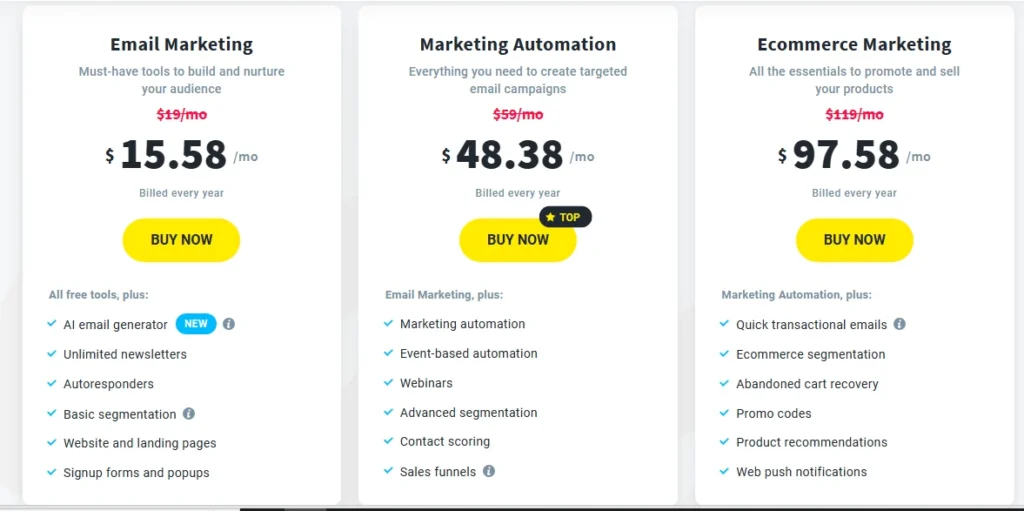
It’s one of the most affordable email marketing tools on the market.
And GetResponse even offers a free account registration option, so you can try it out before you buy it.
Best For
GetResponse is suitable for:
- Businesses and Entrepreneurs (small businesses, large businesses, startups, intrapreneurs, hustlers, content creators)
- Online marketers
- Marketing managers
- Corporations
GetResponse’s Email Marketing Key Features:
As an email marketing platform, GetResponse provides:
- Campaign management
- Autoresponders
- A/B testing
- Email marketing templates to improve the speed of creating new campaigns
- Campaign reporting to track campaign progress
- Segmentation for more effective marketing
- Activity Dashboard to see an overview of all your marketing activities in a day, month, or year.
- Third-Party Integrations to drive more power and features into the Getresponse platform.
- Customizable Templates to get things to your taste easily.
- Campaign Analytics to monitor your spending and ROI.
- List management to manage and track your email list.
More Tools and Features offered by GetResponse:
GetResponse has also advanced to more than being an email tool alone.
And when you are ready to upgrade from just an email marketing tool, you get a marketing suite of tools that include:
- Ecommerce marketing automation
- Multichannel engagement
- Landing pages and a landing page builder (with free hosting)
- One-click integrations
- Website Builder (with free hosting)
- Webinars
- Conversion funnels
- etc
Despite this load of features, you don’t need to be tech-savvy to create and send emails with Getresponse.
Packages and Pricing

Getresponse offers four main packages that cater to everyone and mid to large companies.
- Free Plan
- Email Marketing Plan
- Marketing Automation Plan
- Ecommerce Marketing Plan
1. Free: As the name suggests, goes for FREE, no credit/debit card is required, and offers all the essential features an email marketing tool needs such as newsletters, landing page, and website builders where you can connect your own domain, an email list of up to 500 contacts max, signup, and contact forms.
2. Email Marketing: Costs $15.58/mo and comes packed with all free email tools plus premium email marketing features such as an AI email generator, autoresponders, basic segmentation, unlimited newsletters, unlimited landing pages, website builder, email scheduling, signup forms, and popups.
3. Marketing Automation: Costs $48.38/mo and you’ll get all features in the email marketing plan in addition to even more advanced marketing automation features including event-based automation setting, access to create and host webinars, advanced list segmentation, contact scoring, and sales funnels.
4. Ecommerce Marketing: Costs $97.58/mo and comes with all marketing automation features plus, web push notifications, webinars, quick transactional emails, product recommendations, abandoned cart recovery, promo codes, and ecommerce segmentation.
Pros of Using GetResponse
- Ease of use
- Feature-rich
- Ability to segment email lists and personalize outreaches
- Autoresponders
- Design flexibility
- Robust Analytics
Cons
This review wouldn’t be an honest one if I do not also mention some of the downsides of using GetResponse based on my personal experience and research.
You just have to keep in mind that no tool can have it all and these cons do not mean bad.
- Cost: While GetResponse provides a robust set of features, it may be more expensive than other email marketing solutions. But it is still cost-effective as the cost only increases as your list size grows.
- Tier Plans: Some features are only available in higher-tier plans. That’s very understandable and also, you will rarely need a tool that’s not available in a plan you subscribed for as their names are very descriptive and communicates what they are perfect for; as an Emal Marketing plan is only suitable as an email marketing tool while Ecommerce Marketing plan for? You guessed right, ecommerce and ecommerce marketing.
- Learning Curve: Despite its overall user-friendly interface, the platform’s numerous features can present a learning curve for some users. A walk-around will be to focus on only what you need, with time, you will get to understand and love it.
- Customer Support: While GetResponse offers customer support, there have been some user complaints about the quality and responsiveness of the support provided. This is from my research as I have not really run into such issues personally.
2. ActiveCampaign – Best for automated customer experiences
Best growth with customer experience automation email tool.
Read my ActiveCampaign full review here ↗.
ActiveCampaign is another one of the most effective email marketing tools out there that can help you with your email marketing with actual results and speedily grow your business.
With automation tools that propel your business forward, marketing tools that drive site and business growth, sales tools that get you to surpass your sales goals and engage leads like never before, to multiple integrations and multiple awards, ActiveCampaign easily ranks on the list of go-to email marketing platforms.
It can help you to create and send newsletters, track your results, and improve your campaigns.
It also integrates with a variety of other tools, which makes it a versatile tool.
User Experience
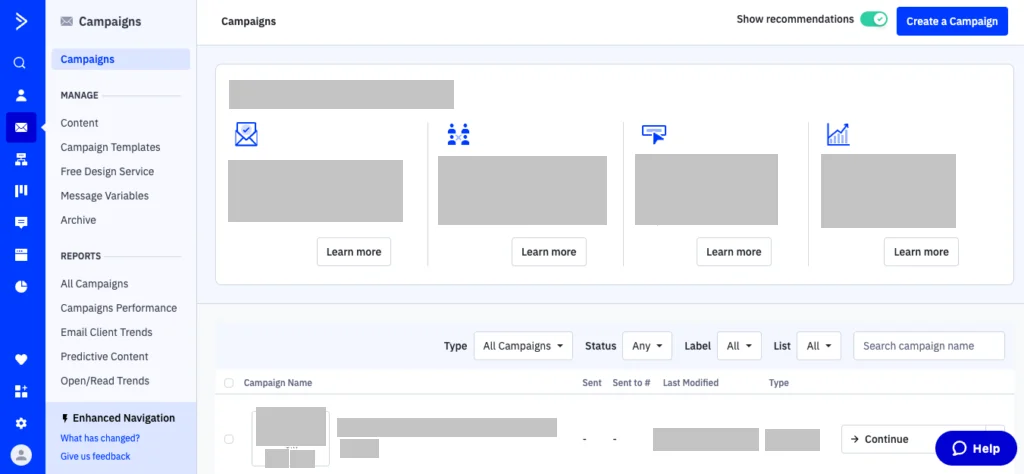
One of the best things about ActiveCampaign is that it is user experience first, which means ease of use.
Once you land on your account dashboard, you can choose where to go from here. Whether to:
- Automate customer journeys
- Automate target campaigns, or
- Build forms and landing pages,
- Automate your leads or dive into the CRM feature.
Talking about CRMs, here is a reviewed and ranked list of the Best CRM Software.
ActiveCampaigns’ analytics feature lets users track the results of their campaigns in detail. And the integration with other tools is also a plus, as it means that you can use ActiveCampaign to manage almost all of your marketing campaign needs just from one interface.
This without question can save you time and make it easier to manage your campaigns.
Overall, ActiveCampaign is just a suitable tool for all of your email marketing tool needs, it is easy to use, versatile, and integrates well with other tools.
If you are looking for a good tool to help you with your email marketing, then ActiveCampaign is definitely a no-brainer.
Key Features
- Ecommerce
- Pages
- Email Marketing
- Email Segmentation
- Subscription Forms
- Site Tracking
- Marketing Automation
- Messaging & Text (SMS)
- Automation Map
- Automation Goals
- Dynamic Content
- Event Tracking
- CRM & Sales Automation
- Contact & Lead Scoring
- Pipelines
- Win Probability
- Split Action
- Attribution
- Conversations & Chat
- Loyalty
- Split Testing
- Predictive Sending
- Predictive Content
- Site Messages
Pricing and Packages

ActiveCampaigns pricing looks like this:
- Lite Plan: $9/month, billed annually.
- Plus Plan: $49/month, billed annually.
- Professional Plan: $149/month, billed annually.
- Enterprise Plan: Custom pricing.
Pros of Using ActiveCampaign
- Accelerated onboarding
- Contact migration
- Learning resources such as customer enablement workshops, video tutorials, knowledge base, and help guides
- Support via chat and support tickets
- CRM Features: ActiveCampaign includes a built-in CRM system that integrates directly with its email and automation features, which is especially useful for sales teams.
- Advanced Automation: ActiveCampaign excels in its automation capabilities as it allows it to build complex and layered automation with ease.
- Segmentation: The tool allows for advanced segmentation of contacts, which can lead to more personalized and effective campaigns.
- User-Friendly Interface: The platform is generally easy to use with a clean, intuitive interface.
- Third-party Integrations: ActiveCampaign integrates well with other third-party tools, which extends its capabilities even further.
- Analytics and Reporting: ActiveCampaign provides comprehensive reports that can help you monitor and optimize your campaigns.
- API & Webhooks
- WooCommerce, Shopify & BigCommerce Integrations
Cons:
- Pricing: While ActiveCampaign offers a robust set of features, it can be more expensive than other marketing automation tools, especially as your contact list grows. I guess that’s one of the prices you pay for using one of the best email marketing tools.
- Learning Curve: While the user interface is generally friendly, the advanced features of ActiveCampaign can present a steep learning curve, especially for beginners.
- Email Templates: Based on my last research, some users find the email templates somewhat limited or outdated compared to other platforms. That probably has changed now.
- Complexity: While its advanced features are a strength, they can also make the platform overwhelming for users who are looking for just a simple email marketing tool.
3. Moosend – Best for targeted email campaigns
Moosend is our next best email marketing tool which shines ever so brightly and is especially best for targeted email campaigns.
It helps businesses to create and send newsletters, email campaigns, and other automated emails.
Moosend offers a drag-and-drop email builder, automated email workflows, subscriber segmentation, email tracking, and much more.
It also provides a lot of integration options with other platforms, such as Shopify, WordPress, and Salesforce, as well as with other email marketing platforms, such as Mailchimp and Campaign Monitor.
This allows businesses to use Moosend to manage all their email marketing needs in one place.
User Experience
Moosend offers a clean and user-friendly interface that allows you to design and launch email campaigns effortlessly.
The platform is designed to make your life easier with its drag-and-drop email editor and easy-to-use automated workflows.
Its visual workflow builder aids in mapping out and understanding your customer’s journey with ease.
Also, the Moosend email marketing tool provides advanced display rules and gamification forms to help you to improve the personalization of emails to subscribers and grow email lists effectively.
For beginners, the platform offers thorough learning resources, and step-by-step video guides to learn at your own pace.
Pricing and Packages
Moosend’s plans are tailored to cater to the needs of businesses of all sizes:
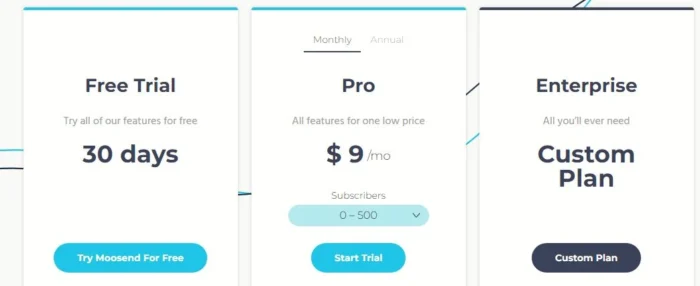
- Free Trial (30 days) Plan– No credit card/debit card required. It includes unlimited emails, 1x automation workflow, 1x landing page, and 1x form, along with SMTP Server access.
- Pro Plan: Starts from $9/mo for 0-500 email list subscribers. This plan comes with features like unlimited emails, multiple automation workflows, landing pages/forms, an account manager, and SMTP Server access.
- Enterprise: This plan caters to large businesses with all Pro features plus dedicated account management, priority support, SSO & SAML, and a dedicated IP. Pricing details can be obtained with a quote.
Pros of Using Moosend
- Simple, user-friendly interface: Moosend’s platform, like other of our highly ranked tools on this list, is easy to navigate, and its tools are intuitive to use. This makes it ideal for both beginners and experienced email marketers.
- Range of features: From the drag-and-drop email builder and automated email workflows to subscriber segmentation and email tracking, Moosend offers a comprehensive suite of tools for effective email marketing which is one of what makes an email marketing program the best.
- Extensive integration options: Moosend’s integrations with popular platforms like Shopify, WordPress, Salesforce, Mailchimp, and Campaign Monitor allow businesses to manage all their email marketing needs from one place.
- Affordable pricing: With plans starting at just $9/mo for up to 500 subscribers, Moosend is a cost-effective solution for small businesses. The platform also offers a 30-day free trial.
- Excellent customer support: Moosend’s customer support is available 24/7 via live chat or email, ensuring users have assistance whenever they need it.
Cons of Using Moosend
- The free trial version has limited features: Although Moosend offers a free 30-day trial, some features, like multiple automation workflows and landing pages, are restricted.
- The pricing for the Enterprise plan is not transparent: Businesses interested in the Enterprise plan must request a quote, which may not be convenient for some users. This might not really be a con as most other businesses do the same, moreover, as businesses get bigger, the need to tailor a plan specifically to them becomes even more important.
- Limited customization options: While Moosend offers a range of templates, there may be limited options for customization compared to other email marketing tools. That probably must have changed now.
- Lack of built-in CRM: Although Moosend can be integrated with CRM platforms, it doesn’t offer a built-in CRM function, which some competitors do.
My Take
Moosend is a powerful and easy-to-use email marketing tool with a wide range of features and integrations. It’s a reliable option for businesses looking to streamline their email marketing efforts and deliver highly targeted campaigns. However, users should consider the potential drawbacks such as limited customization options and the lack of a built-in CRM. A free trial is available for businesses interested in testing out the platform before committing to a paid plan.
4. Constant Contact
Makes it easy to create beautiful emails that look great on any device from an easy-to-use interface and is one of the best feature-packed marketing platforms, if you’re looking for a great email marketing tool, Constant Contact is a great option.
For other tools, it was user experience, but one of the best things about Constant Contact is the support you get from the company.
You can access help from the support team 24/7, and they have a huge library of resources to help you get the most out of your account.
Key Features
- Automatic email marketing
- Event marketing
- Customer list management
- Survey tools
- Reporting
- Integrations including Facebook integration
- Templates
- Marketing automation
Pricing and Packages

Out of the two packages offered by Constant Contact, The Digital Marketing package comes with two different plans:
1. Core: – $9.99/m Customer list growth tools, email Marketing, 300+ email templates, store, organize and view contacts, etc.
2. Plus: – $45/m, Additional list growth tools (Google ads integrated, text message sign-up, lookalike ad targeting), automated emails (resend to non-openers, abandoned cart reminder, birthday/anniversary), auto-generated segments (most, somewhat, least engaged), conversion and sales reporting, personalized kickoff call.
5. MailChimp
MailChimp is a popular email marketing tool, best for beginners, that helps you to easily create, send, and track emails.
With MailChimp, there are lots of templates and pre-made designs available to help you create beautiful newsletters, popups, embedded forms, campaigns, and a lot more.
You can also create your own custom templates or use one of the many integrations available to easily add MailChimp to your website or blog.
MailChimp also makes it easy to track the success of your email campaigns directly from your account dashboard.
And every time you send out emails, you can see how many people opened your email, clicked on any links, subscribed to your newsletter, unsubscribed from your list, or marked your email as spam (nobody wants this one :)).
MailChimp is FREE for up to 2,000 subscribers (one of the highest out there) and 12,000 emails per month.
Read my full review of the MailChimp email marketing features here.
There are also a number of paid plans available, starting at $11/month. Pricing details in a moment.
Key Features of MailChimp
- Free for up to 2,000 subscribers
- 12,000 free email sends per month.
- 250+ app integrations
- Award-winning support for round-the-clock support.
- Audience management.
- Creative tools
- Insights and analytics to get a summary of progress in one place.
Pricing and Packages
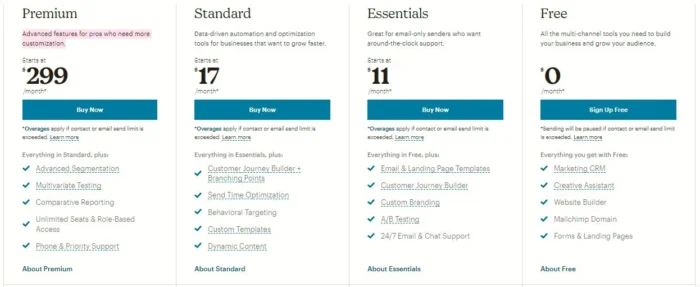
The prices of MailChimp plans solely depend on the size of your contacts, for 500 contacts, it looks something like this:
- Free: at $0/mo, All the multi-channel tools you need to build your business and grow your audience.
- Essentials: at $11/mo, Great for email-only senders who want around-the-clock support.
- Standard: at $17/mo, Data-driven automation and optimization tools for businesses that want to grow faster.
- Premium: at $299/mo, Advanced features for pros who need more customization.
Additionally, MailChimp has special plans for “Website and Ecommerce” and “Traditional Email” use cases.
6. AWeber
With AWeber as your best email marketing service of choice, you as a creator, small business, or entrepreneur can cultivate relationships with customers through email newsletters, autoresponders, and other automated email content like it was nothing.
AWeber allows you the ability to create sign-up forms, automatically send follow-up emails after a purchase or signup, and track the delivery and success of email campaigns.
It also integrates with a number of popular e-commerce platforms, including Shopify and WordPress, which sure makes it easy to add email marketing content to your existing website.
Pricing and Packages

Read my full dive into AWeber in this review post.
7. HubSpot
If you agree email marketing is one of the most effective ways to reach and engage your customers. And agrees that to be successful, you need the right tools.
You will also agree that HubSpot is one of the most popular and effective email marketing tools available.
HubSpot is actually a hub of marketing, sales, customer service, CMS, operations, and free tools, but the features you need include:
- Automatic list management and segmentation
- A/B testing
- Email templates
- Real-time reporting
HubSpot also integrates with other popular tools, such as Salesforce and Google Analytics, making it easy to track your email marketing campaign’s success and optimize your strategies accordingly.
Pricing and Packages

Read my full review of HubSpot here.
8. MailerLite
As a versatile email marketing tool, MailerLite facilitates the creation and delivery of a wide range of email campaigns including newsletters and announcements.
Its core features include A/B testing, list segmentation, and automated email marketing, catering to a broad spectrum of email marketing needs.
A distinguishing factor for MailerLite is its free plan, which allows sending up to 1,000 emails per month. This budget-friendly option is ideal for startups, small businesses, and bloggers venturing into email marketing.
Overall, the diversity of features coupled with its affordability positions MailerLite as a compelling choice for businesses of all sizes exploring email marketing tools.
Pricing and Packages
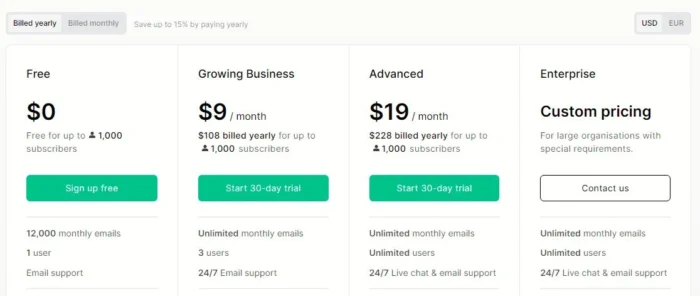
For more details, read my full review of MailerLite here.
9. ConvertKit
ConvertKit steps in as a dynamic tool for curating, dispatching, and monitoring email campaigns.
Its drag-and-drop editor simplifies the creation of aesthetically pleasing email campaigns. You can integrate content blocks, images, and videos to establish a polished and professional look.
Notably, ConvertKit is equipped with an advanced email automation feature. This allows you to generate automated email sequences that engage your subscribers based on their interactions with your campaign.
Besides automation, ConvertKit excels in providing in-depth analytics. You can monitor the performance of your email campaigns, optimizing them for better outcomes based on the insights obtained.
Pricing and Packages

Dive deeper into the features with my full review of ConvertKit here.
10. Campaign Monitor
Campaign Monitor is a comprehensive tool that elevates your email marketing game, facilitating the creation of visually appealing newsletters and tracking the performance of your campaigns.
Its intuitive newsletter creation process begins with choosing a template and integrating your content. It further offers a wide range of fonts and colors, empowering you to create newsletters that resonate with your brand.
As a data-driven tool, Campaign Monitor tracks the key performance indicators of your email marketing — open rates, click rates, and unsubscribe rates — helping you optimize your campaigns for higher engagement.
Pricing and Packages
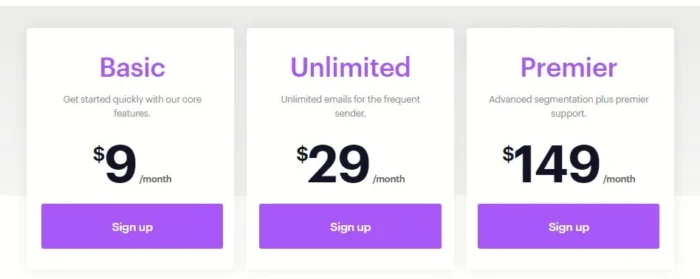
For an in-depth look, read my full review of Campaign Monitor here.
11. Drip
Drip simplifies email marketing by offering automation features that allow constant customer engagement. It excels at designing custom, timed emails that are automatically sent based on user behavior on your site.
Drip empowers you to craft targeted campaigns based on individual customer interests and interactions, optimizing communication strategies.
What sets Drip apart is its tracking ability. It allows you to gauge your campaign’s impact by monitoring metrics like email opens, link clicks, and even conversions.
This detailed insight helps fine-tune your strategies and ensures optimal returns on your email marketing investments.
Pricing and Packages

Discover more in my comprehensive review of Drip.
12. Omnisend
Omnisend is a versatile tool that goes beyond email marketing, offering features such as automated campaigns, customizable web forms, and even SMS marketing.
The automation capabilities extend to creating tailored email sequences and marketing funnels that adapt to user behavior and lead score, ensuring relevance and high engagement rates.
The customizable web forms feature of Omnisend offers a seamless way to gather customer data, essential for targeted marketing efforts.
With its SMS marketing feature, businesses can keep customers engaged on a whole new level, targeting messages based on location, purchase history, and other user behaviors.
Pricing and Packages

For more on Omnisend, check out my detailed review here.
15. Brevo (ex. Sendinblue)
Best Marketing Toolkit If you are starting out.
There are a number of email marketing tools on the market, but few can compare to Brevo (ex Sendinblue) when it comes to features and affordability.
A French gem in the world of email marketing, Brevo (formerly known as Sendinblue), is your affordable and feature-rich marketing companion. Designed to cater to both newbies and veterans alike, Brevo sets itself apart with its pricing and impressive feature set.
Founded in 2007, Brevo quickly carved a niche for itself in the email marketing landscape due to its affordability and an array of features.
Key Features
- Robust email creation and design tools: Craft engaging emails without needing any coding expertise.
- SMS marketing: Extend your outreach beyond emails.
- Inbuilt chat: Interact in real-time with your visitors.
- Automated email marketing: Schedule and automate emails to maintain constant engagement.
- A/B testing: Test and figure out what works best for your audience.
- Email Segmentation: Tailor your messages to cater to specific segments of your audience.
- Email tracking and reporting: Understand your campaign performance to optimize your strategies.
- Email delivery optimization: Ensure that your emails reach the recipient’s inbox, not their spam folder.
- Customer support: Round-the-clock support to handle your queries and issues.
Brevo’s budget-friendly plans are one of its most attractive features. Their free plan allows unlimited contacts and a daily limit of 300 emails, perfect for small businesses and startups. For larger email volumes, their Lite plan starts at a competitive price of $25 per month for a 20,000 monthly email volume.
Pricing and Packages
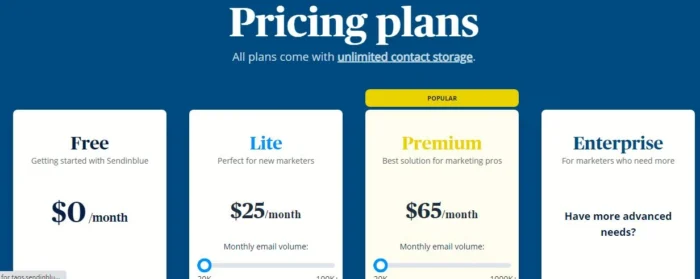
There are four plans to choose from based on your marketing needs. Based on a 20k email monthly volume, Brevo (ex Sendinblue) offers:
- Free: – $0/m
- Lite: – $25/m
- Premium: – $65/m
- Enterprise: – Custom pricing
For a more in-depth exploration, read my full review of Brevo (ex. Sendinblue) here.
16. Mailjet
When it comes to creating, sending, and tracking email marketing campaigns, Mailjet provides a robust and intuitive interface. With its rich feature set, you can effortlessly design newsletters, automate responses, and monitor campaign performance.
Beyond its core capabilities, Mailjet’s seamless integrations with other marketing and sales tools ensure you get the most out of your marketing activities. For budding businesses, Mailjet offers a free tier that accommodates up to 6,000 emails per month.
Pricing and Packages

To know more about how Mailjet can turbocharge your marketing efforts, read my full review of Mailjet here.
17. iContact
Whether you’re a beginner stepping into email marketing or an expert seeking more control, iContact has you covered. This versatile tool comes with a host of features designed to help you craft effective campaigns that resonate with your audience.
From designing aesthetic newsletters to tracking campaign success and scheduling autoresponders, iContact equips you with everything you need for a successful email marketing campaign. Plus, its integrations with various platforms make it an ideal choice for businesses juggling multiple tools.
Pricing and Packages
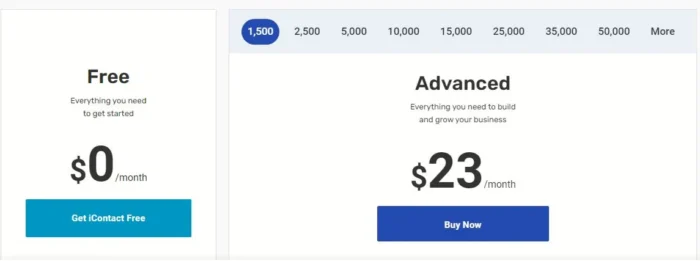
Discover more about iContact’s offerings in my full review of iContact here.
18. SendGrid
SendGrid is a cloud-based email delivery service that simplifies the way you manage your email marketing campaigns. Designed for businesses that need to send bulk emails, it provides in-depth performance reports to help refine your strategies.
Pricing and Packages

Uncover more about SendGrid’s capabilities in my full review of SendGrid here.
19. Keap
Specifically tailored for small businesses, Keap is a feature-rich email marketing tool that focuses on fostering stronger customer relationships. Its arsenal includes functionalities to create and dispatch newsletters, monitor customer engagement, and orchestrate automated email marketing campaigns.
Pricing and Packages
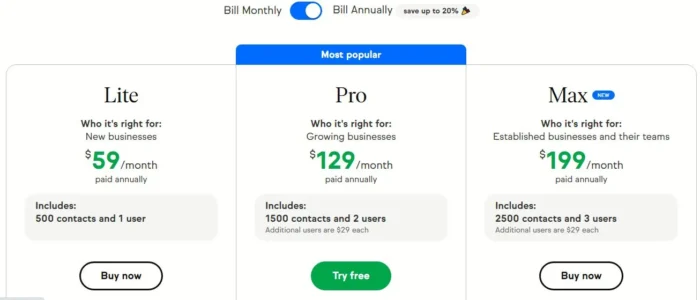
Delve deeper into what makes Keap a valuable asset for small businesses in my full review of Keap here.
20. SendPulse
Streamlining your email campaigns is effortless with SendPulse. Designed with ease-of-use in mind, this tool provides a suite of features tailored for robust email marketing strategies.
From automated marketing campaigns and precise A/B testing, to in-depth email analytics, SendPulse is your one-stop platform for efficient customer reach. It harmoniously integrates with WordPress, Shopify, and a multitude of other platforms, reinforcing its utility and flexibility.
The cherry on top? They offer a free plan, allowing you to dispatch up to 15,000 emails per month. For businesses craving potency and simplicity in their email marketing arsenal, SendPulse is a commendable choice.
Pricing and Packages

Delve deeper into SendPulse’s offerings in my comprehensive review here.
21. Marketo
Marketo epitomizes sophistication in email marketing tools. It grants businesses the capability to concoct highly personalized email campaigns with fine-tuned precision.
Flourish your email list segmentation by demographics, interests, and behaviors. Design targeted messages that genuinely connect with your audience. Harness the power of its advanced analytics and reporting tools to measure your campaign’s impact, refining your strategies for maximum engagement.
Pricing and Packages
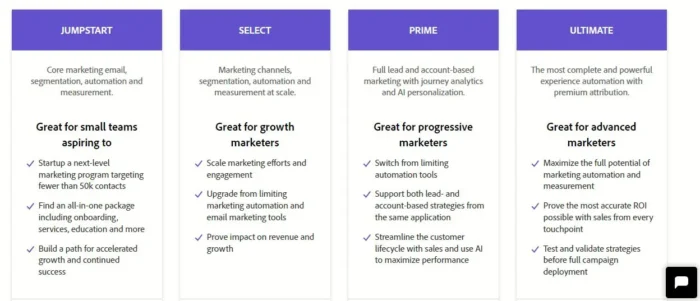
For an in-depth look at Marketo, check out my detailed review here.
22. Salesforce Marketing Cloud
Embrace an all-encompassing approach to your email marketing with Salesforce Marketing Cloud. It equips businesses with the tools to craft, dispatch, and monitor the impact of their email campaigns.
Here’s what’s in store for you with Salesforce Marketing Cloud:
- Intuitive campaign creation and design tools
- Accurate A/B testing
- Real-time reporting and analysis
- Effective list segmentation
- Timely autoresponders
Seamlessly syncing with other Salesforce products like Salesforce CRM and Salesforce Pardot, Salesforce Marketing Cloud serves as a solid foundation for businesses employing Salesforce CRM.
On the hunt for a comprehensive tool that elevates your email marketing to new heights? Salesforce Marketing Cloud may just be your perfect fit.
Dive into the workings of Salesforce Marketing Cloud in my thorough review here.
What Are Email Marketing Tools
Email marketing tools are those dedicated computer algorithms and software used in the process of sending commercial messages, typically to a group of people, using email.
On the other hand, email marketing is a direct marketing technique that involves sending a commercial message to a group of people via email.
Email marketing can be extremely effective in driving traffic to your website, building brand awareness, and generating leads and sales.
It can also be a great way to keep in touch with your customers and keep them updated on your latest products and services.
Types of Email Marketing Tools
There are a variety of email marketing tools available, each with its own benefits and drawbacks. The most important thing is to find a tool that fits your needs and your budget.
Some common email marketing tools include:
Email service providers (ESPs)
These are companies that provide software to help you create, send, and track your email campaigns. Some popular ESPs include MailChimp, Campaign Monitor, and Constant Contact.
Email marketing software
This is software that you can use to create and send email campaigns on your own computer. Some popular software programs include AWeber, Infusionsoft, and iContact.
Email marketing platforms
These are services that provide all of the tools you need to create and send email campaigns, including email service providers, email marketing software, and lead capture forms. Some popular email marketing platforms include HubSpot, Marketo, and Pardot.
Features of email marketing tools
There are many different types of email marketing tools available, but all of them have some common features.
The first thing to look for is the ability to create sign-up forms. These forms can be embedded on your website or blog, or you can use a tool to create them for you. The forms should be easy to use and customizable, so you can match them to your website’s design.
The tool should also allow you to create newsletters and other email content. You should be able to easily create HTML or text-based emails, and you should be able to include graphics and other multimedia content.
Another important feature is the ability to track your email campaigns. The tool should track how many people open your emails, click on links, and take other actions. This information can help you to improve your email campaigns and measure their success.
Finally, the tool should be easy to use. It should be easy to create and send emails, and it should be easy to track the results of your campaigns.
What Are The Benefits of Email Marketing?
Mass Reach Out
Email marketing is one of the most efficient and effective ways to reach and engage customers.
Boost Relationship
It allows you to cultivate relationships with customers by sending them targeted content that is relevant to their interests.
Build Trust
Email marketing also allows you to build loyalty and trust with customers by providing valuable content that helps them solve problems or learn something new.
Increase Sales
Additionally, email marketing can help you increase sales and revenue by promoting your products or services to customers who are likely to be interested.
Overall, email marketing is a powerful tool that can help you improve your customer relationships, increase sales and revenue, and boost your business.
The Basics of Email Marketing and Why It Works
It’s A Form Of Direct Marketing
Email marketing is a form of direct marketing that uses email messages to promote products or services.
Reach A Large Audience
And it can be very effective because it allows you to reach a large number of people who are interested in what you have to say.
Targeting
Email marketing also allows you to target your audience by demographics, interests, and past behaviors.
Increase Brand Awareness
Email marketing can be used to increase brand awareness, drive traffic to your website, and increase sales.
Cost-Effective Marketing
Email marketing is a cost-effective way to reach your target audience.
Keep In Touch
Email marketing is a great way to keep in touch with your customers and prospects.
Send To Only Interested People
Email marketing is a permission-based marketing strategy, which means that people must opt-in to receive your emails.
Build True Friendships
Email marketing is a great way to build relationships with your customers and prospects.
Don’t Get Forgotten
Email marketing is a great way to stay top of mind with your customers and prospects.
Build A Circle of Loyal Prospects
Email marketing can be used to create loyalty among your customers and prospects.
Keep Them In The Know
It is also a great way to keep your customers and prospects informed about your products or services.
Types of email marketing
There are a variety of different types of email marketing, but the most common are:
1. Newsletters
Newsletters are a great way to keep your subscribers updated on your latest products, services, or blog posts.
They can also be used to drive traffic to your website or blog.
To create a successful newsletter, you need to provide valuable content that your subscribers will find interesting.
This content can include anything from industry news to tips and tricks.
You should also make sure to include a call to action in your newsletters, such as a link to your website or a promotional offer.
2. Announcements
Announcements are a great way to keep your subscribers informed about important updates, such as new products, services, or blog posts.
You should always include a call to action in your announcements, such as a link to your website or a promotional offer.
3. Contest
A contest is a great way to increase engagement and drive traffic to your website or blog.
To run a successful contest, you need to create a compelling prize and make sure to promote it heavily. You can also promote your contest on social media and other websites.
4. Coupons
Coupons are a great way to increase sales and drive traffic to your website or blog.
To create effective coupons, you need to make sure they are visually appealing and easy to print. You should also promote them
How to create an email marketing campaign
Before you start your email marketing campaign, you need to come up with a plan.
Decide what you want to achieve with your campaign, and create a list of goals. Then, determine your target audience and create a strategy for reaching them.
Once you have your plan in place, it’s time to create your campaign. The first step is to create a template for your email. The template should be simple and easy to read, with a clear call to action.
Next, you need to create the content for your email. Be sure to include a strong headline, and make sure the content is relevant to your target audience. You may also want to include images or videos to help grab your readers’ attention.
Finally, you need to set up your email marketing campaign. Choose a service provider, and create a list of subscribers. Then, send out your first email and track the results.
By following these steps, you can create a successful email marketing campaign that will help you achieve your business goals.
Measuring The Success of Your Email Marketing Campaign
There are a number of factors to consider when measuring the success of your email marketing campaign.
Your Marketing Goals
One of the most important is how you define success. What are your goals for the campaign?
Are you trying to increase brand awareness, generate leads, or sell products or services?
Once you know what you’re trying to achieve, you can start to measure whether or not your campaign is successful.
Click-Through and Open Rate
One way to measure success is to look at how many people opened your email and clicked through to your website.
If you have a high open rate and a low click-through rate, it means that your email wasn’t effective at getting people to visit your website.
If you have a low open rate and a high click-through rate, it means that your email was effective at getting people to visit your website, but people weren’t interested in what you had to say.
Conversion Rate
Another important measure of success is how many people converted after clicking through from your email.
If you have a low conversion rate, it means that your email wasn’t effective at getting people to buy your product or service.
If you have a high conversion rate, it means that your email was effective at getting people to buy your product or service.
There are a number of other factors to consider when measuring the success of your email marketing campaigns, such as the number of unsubscribes, the number of complaints, and the amount of money you made from the campaign.
Check out a comprehensive digital marketing glossary here.
What Are Some Email Marketing Ideas?
Email marketing is one of the oldest and most effective forms of digital marketing.
It is a direct channel between your business and your customers, which allows you to communicate with them directly, and often in real-time.
Email marketing can be used to promote your products or services, to announce new features or products, or to simply keep in touch with your customers and let them know what you’re up to.
But, like all digital marketing techniques, email marketing is only effective if it’s done well.
So, how can you make sure your email marketing campaigns are successful?
Here are a few tips:
1. Segment your list
One of the biggest mistakes businesses make with email marketing is sending the same message to everyone on their list.
Your customers are not all the same, and they don’t all want to hear the same thing. So, it’s important to segment your list and send different messages to different groups of customers.
For example, you might want to send a promotional message to your customers who have recently made a purchase, while sending a different message to customers who have never made a purchase.
2. Write great content
Your customers are more likely to open and read your emails if the content is interesting and engaging.
So, make sure you write great content that your customers will want to read. This might include news, updates, or special offers.
Email marketing questions to ask clients
Email marketing can be a great way to stay in touch with your customers and keep them up to date on your latest products and services.
But before you start emailing your customers, you need to ask them some questions to determine what type of email marketing campaign would be the best fit for them.
1. What types of emails would you like to receive from us?
Your customers may want to receive information about new products, special offers, or simply updates on what’s going on with your business.
Ask them what types of emails they would like to receive and then tailor your campaign to fit their needs.
2. What is your preferred method of communication?
Some customers may prefer to receive emails, while others may prefer to receive text messages or phone calls.
Find out what your customers’ preferred method of communication is and then send them information in the format they prefer.
3. What is your preferred frequency of communication?
Some customers may want to receive emails every day, while others may only want to hear from you a couple of times a month.
Find out what your customers’ preferred frequency of communication is and then send them information at the frequency they prefer.
4. What is your preferred content?
Some customers may want to receive information about new products, while others may only want to hear about special offers.
Find out what your customers’ preferred content is and then send them information that appeals to them.
Does email marketing still work?
The answer to this question is a resounding yes!
Email marketing is still one of the most effective ways to reach and engage your target audience.
Despite the rise of social media and other digital marketing channels, email remains one of the most popular ways to connect with customers.
Email is almost 40 times more effective at acquiring new customers than Facebook and Twitter combined, that’s because 91 percent of all US consumers still use e-mail daily. ExactTarget, 2012 Channel Preference Survey
So, why is email marketing still so effective? There are several reasons:
Email is personal.
Unlike social media, where posts can be seen by anyone, email is a more personal communication channel.
People are more likely to open and read emails from people they know and trust.
Email is immediate.
Email is one of the quickest ways to reach your target audience.
Emails are delivered almost instantaneously, which means that you can get your message out quickly and respond to events as they happen.
Email is convenient.
People check their email on a variety of devices, including laptops, smartphones, and tablets. This means that your message can reach your target audience no matter where they are.
Email is affordable.
Email is one of the most affordable digital marketing channels. You can reach a large number of people at a relatively low cost.
So, if you’re looking to reach and engage your target audience, email is still the best way to go.
Email Marketing Tools FAQ
Only send it to people who are most likely to be interested in your offer, or have explicitly requested it. Be clear about the sender, include a way to unsubscribe, and be honest about its content.
There are roughly four types of email marketing:
Transactional emails, marketing emails, newsletters, and autoresponders.
A good email answer is relevant, concise, and helpful. It should also be tailored to the individual customer’s needs.
Relevant: The answer should address the question or concern that the customer has raised.
Concise: The answer should be brief, but comprehensive.
Helpful: The answer should provide the customer with the information they need to make a decision.
Tailored: The answer should be specific to the customer’s individual needs.
Conclusion
Email marketing tools are an important part of any online marketer’s arsenal.
They allow you to reach a large number of people with your marketing message, and they make it easy to track the results of your campaigns.
There are a number of different email marketing tools available, and the best one for you will depend on your needs and budget.
You can’t go wrong with any of the best email marketing tools I have covered in this post, feel free to check out GetResponse, ActiveCampaign, or Keap.




